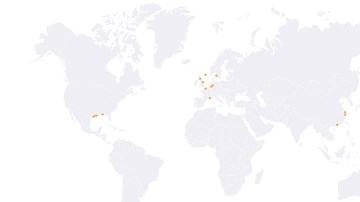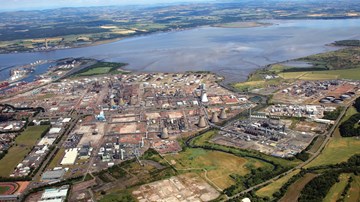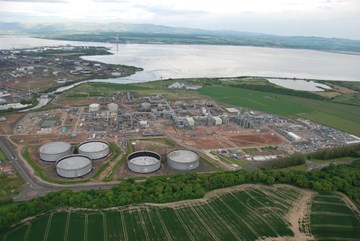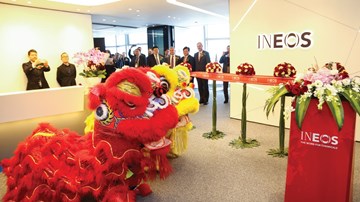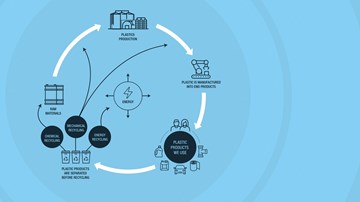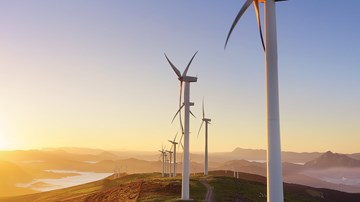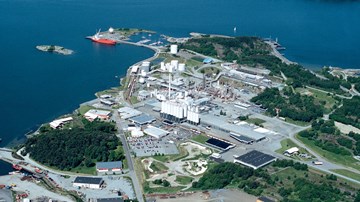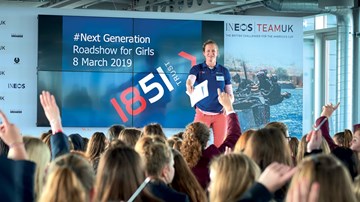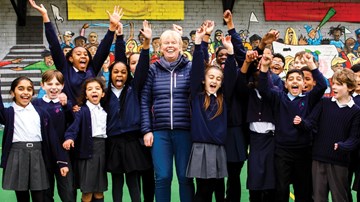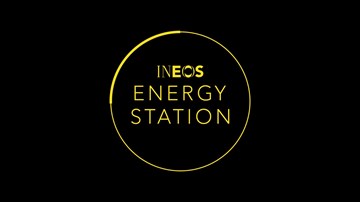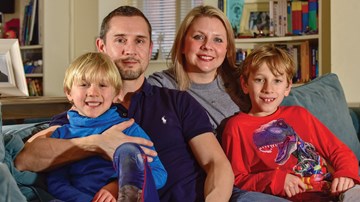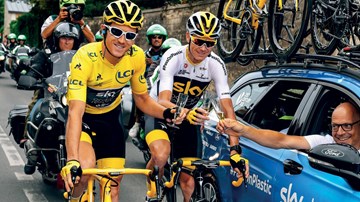1. Fitter, leaner, healthier, happier.
To date, over 1.7 million children in 61 countries now regularly run The Daily Mile, a simple initiative dreamed up by a Scottish headteacher who was worried about her unfit pupils.
“I can hardly believe it myself,” said founder Elaine Wyllie.
Since that day in 2012, when Elaine witnessed her own pupils wilt after attempting to run around the school field without stopping, her simple campaign has won worldwide recognition and backing from the likes of Wimbledon champion Sir Andy Murray, athlete Sir Mo Farah, Manchester United footballer Jesse Lingard and more recently The Duchess of Cambridge.
Research has shown that children who run it are not only fitter, leaner, healthier and happier, but they are also more eager to learn when they return to their desks.
In short, it has been absolutely phenomenal. Yet, few had heard of Elaine until 2015 when she was named Teacher of the Year in the Pride of Britain awards. At that star-studded awards ceremony in London, Elaine was so star-struck, snapping selfies with the likes of Ozzy Osbourne, that she missed her last bus back to the hotel.
But the following day, other schools started taking notice of what she was doing, as did INEOS Chairman Sir Jim Ratcliffe.
He had founded a similar initiative, GO Run For Fun, and decided to meet Elaine to see if INEOS could help financially to roll out the programme.
It was a meeting of minds. INEOS was on board.
By March 2016, The Daily Mile Foundation was officially launched, and things started snowballing.
Studies were being carried out into the effects of a child taking a quick break from their desks every day.
Children from a primary school in Surrey in the UK revealed they had run 58,522 miles since The Daily Mile was launched in their school. That’s effectively running around the world. Twice.
In May last year, UK Prime Minister Theresa May praised The Daily Mile in the House of Commons as an ‘excellent programme’ and called on schools to sign up.
Two months later the Government’s Childhood Obesity strategy was published and included the ‘fantastic Daily Mile initiative’ as a way to ‘improve the physical, social and mental wellbeing of our children regardless of age, ability or circumstance.’
Last year, ITV partnered with The Daily Mile, launching its first-ever ad campaign and offering editorial coverage.
The result was amazing. The number of schools signups increased by 150%.
This year Hollywood film-makers 20th Century Fox have helped to launch an innovative new ad campaign to encourage children to rise up and run The Daily Mile.
A spoof trailer of The Kid Who Would Be King was released on ITV just a few days before the film, about a modern-day schoolboy who finds King Arthur’s legendary sword, opened at cinemas throughout the UK.
In it, the star of the movie, Angus Imrie, tells pupils at the fictitious Dungate Academy: “You must gather your team of knights. Your quest is to join The Daily Mile and get fit for life. Who will swear allegiance and run with us?”
Every day a school, wanting to adopt The Daily Mile, gets in touch with the team at The Daily Mile Foundation, who are based in INEOS' Hans Crescent, London, office.
For Elaine, who was awarded an MBE in this year’s New Year’s Honours List, it doesn’t get much better than this.
But as time has shown, again and again, it most certainly can.
2. Movie stardom
Hollywood Knights Lay Down the Gauntlet to Children Everywhere.
A SPOOF trailer of The Kid Who Would Be King has been made – to encourage children to rise up, take charge of their health and run The Daily Mile.
The trailer was released, with 20th Century Fox's blessing, on ITV just a few days before the film (which is about a modern-day schoolboy who finds King Arthur's legendary sword) opened at cinemas throughout the UK.
It features all the main stars, including Angus Imrie (Merlin the wizard), Louis Ashbourne Serkis (the boy who finds King Arthur’s legendary sword) and Rebecca Ferguson (an evil sorceress and old enemy of Merlin).
In it, Angus tells pupils from the fictitious Dungate Academy: “You must gather your team of knights. Your quest is to join The Daily Mile and get fit for life. Who will swear allegiance and run with us?”
Maria Buttaci, Partnerships Manager at 20th Century Fox, said they were delighted to be partnering with ITV, INEOS and The Daily Mile.
“The Daily Mile is a wonderful initiative that aligns perfectly with the film’s central theme of encouraging children to unite together for an epic quest,” she said.
The stars of The Kid Who Would Be King took a rest from filming to shoot a trailer calling on children everywhere to rise up - and run The Daily Mile.
3. Focus on academic achievement
The university, which has given the world penicillin, synthetic dyes and holography, is now exploring the merits of The Daily Mile.
London’s Imperial College has agreed to work with The Daily Mile Foundation to collate all the research that has already been published or is due to be published over the next three years. It will then build a structured study to test the impact of the initiative on children’s mental and physical health, which can be more widely adopted across the world.
The research will include the UK Government-supported National Childhood Measurement Programme (NCMP) as a secondary data set.
Over the years there has been plenty of anecdotal evidence about the benefits to a child’s health and well-being of running – or walking – The Daily Mile every day. It seems like common sense.
Studies and surveys have shown children are more energised, confident, and do better in the classroom after a 15-minute break from their desks.
The initiative has also won praise from the likes of Sir Mo Farah, Sir Andy Murray and Paula Radcliffe.
What’s been lacking is the scientific proof.
"We're very excited with the growing body of research looking at The Daily Mile around the world. Our partnership with Imperial College London is invaluable, as they can help us independently verify the impact," said Emily Carson, Research Coordinator for The Daily Mile Foundation.
At the end of Imperial College’s research, academics will publish a comprehensive report that covers everything from attainment, mental health, fitness, to the socio-economic effects of implementing The Daily Mile.
The hope is that it will strengthen the Foundation's hand when it approaches policy makers, future partners and key decision makers, as well as motivating more schools to adopt the initiative.
4. £1.5million provides solid foundation for The Daily Mile
Sport England has pledged £1.5 million of National Lottery funding to spread the word about The Daily Mile.
Its new partnership with The Daily Mile Foundation will pay for 11 local, one northern and one national co-ordinator to encourage more school children in England to run – at their own pace – for 15 minutes every day.
But that’s not all.
London Marathon Events Ltd has also joined forces with the Foundation.
From next month, a strategic lead and two part-time staff will be working in the London Marathon offices to encourage every primary school in London’s 32 boroughs to run The Daily Mile.
Sir Mo Farah, who will be running this year’s London Marathon on Sunday April 28, said The Daily Mile was a brilliant and easy way to get kids moving.
“I am a dad of four and I encourage my kids to be active every day,” he said.
So far, about 3,500 schools in England take part in The Daily Mile. The vision, though, is for every school - all 20,000 of them - to be involved.
“This will put rocket boosters under the campaign,” said The Daily Mile’s founder Elaine Wyllie. “It’s absolutely incredible and we are very grateful for the support. They are going to help us roll out The Daily Mile and try to reach every child in England.”
Sport England decided to throw its considerable weight behind the campaign to raise healthier, fitter and slimmer children after publishing the largest childhood measurement survey of its kind – the Children’s Active Lives Survey 2018 – which showed that more than 2.3 million children in England do less than 30 minutes of physical activity a day.
“It was the strongest evidence yet that not enough was being done to support our youngsters, and that change were needed if we were to increase activity levels,” said Tim Hollingsworth, Sport England CEO.
"The support of Sport England will put rocket boosters under the campaign" – Elaine Wyllie
5. Royal blessing
Over the years thousands of parents have witnessed the positive effects of The Daily Mile.
Last month it was royalty’s turn to see how a child’s physical health can affect his or her mental well-being.
The Duchess of Cambridge was at London’s Lavender Primary School as the pupils headed outside to complete 10 laps of the playground during their 15-minute break from the classroom.
She was there as patron of Place2Be, a leading UK children’s mental health charity, to mark UK Children’s Mental Health Week.
The Duchess later shared her experience on the Kensington Palace twitter feed, endorsing the positive benefits of The Daily Mile (@KensingtonRoyal).
Headteacher Jodie Corbett, whose school has been running The Daily Mile for some time, said it was a once-in-a-lifetime experience.
“It is one which we will all cherish for a long time to come,” she said.
FACTS:
1.78m +Number of children running The Daily Mile around the world
0The cost of joining The Daily Mile. It’s free, simple to implement and the children love it
15The number of minutes children should spend outside running, or walking, The Daily Mile at their own pace
2030The UK government wants to halve childhood obesity by 2030 and believes The Daily Mile will be key to helping to achieve that
